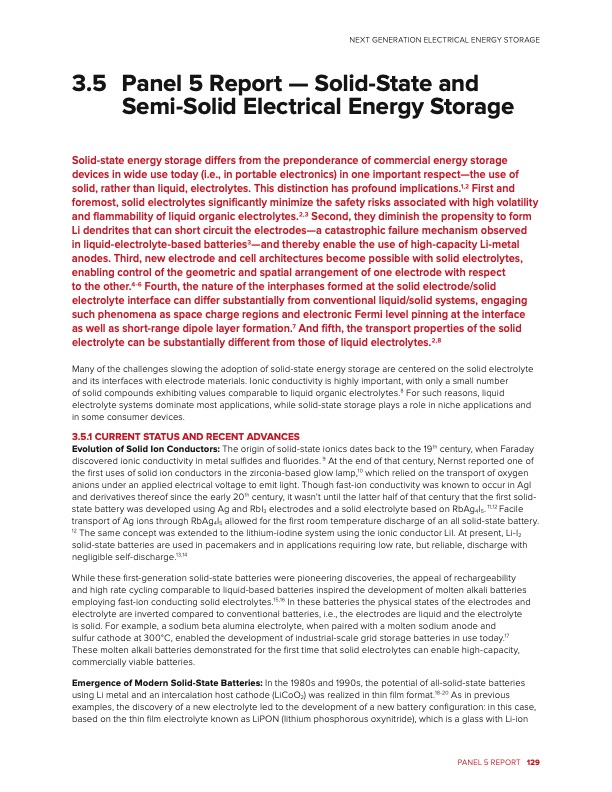
PDF Publication Title:
Text from PDF Page: 135
3.5 Panel 5 Report — Solid-State and Semi-Solid Electrical Energy Storage Solid-state energy storage differs from the preponderance of commercial energy storage devices in wide use today (i.e., in portable electronics) in one important respect—the use of solid, rather than liquid, electrolytes. This distinction has profound implications.1,2 First and foremost, solid electrolytes significantly minimize the safety risks associated with high volatility and flammability of liquid organic electrolytes.2,3 Second, they diminish the propensity to form Li dendrites that can short circuit the electrodes—a catastrophic failure mechanism observed in liquid-electrolyte-based batteries3—and thereby enable the use of high-capacity Li-metal anodes. Third, new electrode and cell architectures become possible with solid electrolytes, enabling control of the geometric and spatial arrangement of one electrode with respect to the other.4-6 Fourth, the nature of the interphases formed at the solid electrode/solid electrolyte interface can differ substantially from conventional liquid/solid systems, engaging such phenomena as space charge regions and electronic Fermi level pinning at the interface as well as short-range dipole layer formation.7 And fifth, the transport properties of the solid electrolyte can be substantially different from those of liquid electrolytes.2,8 Many of the challenges slowing the adoption of solid-state energy storage are centered on the solid electrolyte and its interfaces with electrode materials. Ionic conductivity is highly important, with only a small number of solid compounds exhibiting values comparable to liquid organic electrolytes.8 For such reasons, liquid electrolyte systems dominate most applications, while solid-state storage plays a role in niche applications and in some consumer devices. 3.5.1 CURRENT STATUS AND RECENT ADVANCES Evolution of Solid Ion Conductors: The origin of solid-state ionics dates back to the 19th century, when Faraday discovered ionic conductivity in metal sulfides and fluorides. 9 At the end of that century, Nernst reported one of the first uses of solid ion conductors in the zirconia-based glow lamp,10 which relied on the transport of oxygen anions under an applied electrical voltage to emit light. Though fast-ion conductivity was known to occur in AgI and derivatives thereof since the early 20th century, it wasn’t until the latter half of that century that the first solid- state battery was developed using Ag and RbI3 electrodes and a solid electrolyte based on RbAg4I5. 11,12 Facile transport of Ag ions through RbAg4I5 allowed for the first room temperature discharge of an all solid-state battery. 12 The same concept was extended to the lithium-iodine system using the ionic conductor LiI. At present, Li-I2 solid-state batteries are used in pacemakers and in applications requiring low rate, but reliable, discharge with negligible self-discharge.13,14 While these first-generation solid-state batteries were pioneering discoveries, the appeal of rechargeability and high rate cycling comparable to liquid-based batteries inspired the development of molten alkali batteries employing fast-ion conducting solid electrolytes.15,16 In these batteries the physical states of the electrodes and electrolyte are inverted compared to conventional batteries, i.e., the electrodes are liquid and the electrolyte is solid. For example, a sodium beta alumina electrolyte, when paired with a molten sodium anode and sulfur cathode at 300°C, enabled the development of industrial-scale grid storage batteries in use today.17 These molten alkali batteries demonstrated for the first time that solid electrolytes can enable high-capacity, commercially viable batteries. Emergence of Modern Solid-State Batteries: In the 1980s and 1990s, the potential of all-solid-state batteries using Li metal and an intercalation host cathode (LiCoO2) was realized in thin film format.18-20 As in previous examples, the discovery of a new electrolyte led to the development of a new battery configuration: in this case, based on the thin film electrolyte known as LiPON (lithium phosphorous oxynitride), which is a glass with Li-ion NEXT GENERATION ELECTRICAL ENERGY STORAGE PANEL 5 REPORT 129PDF Image | Next Generation Electrical Energy Storage

PDF Search Title:
Next Generation Electrical Energy StorageOriginal File Name Searched:
BRN-NGEES_rpt-low-res.pdfDIY PDF Search: Google It | Yahoo | Bing
Sulfur Deposition on Carbon Nanofibers using Supercritical CO2 Sulfur Deposition on Carbon Nanofibers using Supercritical CO2. Gamma sulfur also known as mother of pearl sulfur and nacreous sulfur... More Info
CO2 Organic Rankine Cycle Experimenter Platform The supercritical CO2 phase change system is both a heat pump and organic rankine cycle which can be used for those purposes and as a supercritical extractor for advanced subcritical and supercritical extraction technology. Uses include producing nanoparticles, precious metal CO2 extraction, lithium battery recycling, and other applications... More Info
| CONTACT TEL: 608-238-6001 Email: greg@infinityturbine.com | RSS | AMP |